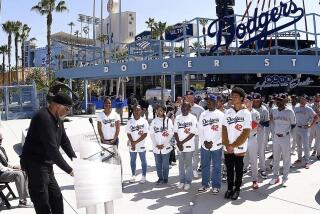Ralph Edwards, 92; Producer, Genial Host of ‘Truth or Consequences,’ ‘This Is Your Life’
Ralph Edwards, the pioneer radio and television host and producer who created the landmark audience participation show “Truth or Consequences” and the long-running sentimental favorite “This Is Your Life,” died Wednesday. He was 92.
Edwards, a three-time Emmy Award winner whose broadcasting career began on radio when he was a teenager in 1929 and spanned more than seven decades, died in his sleep of natural causes at his home in West Hollywood, publicist Laura Calliari said.
The onetime radio announcer who was responsible for thousands of hours of radio and television programming as a producer received a lifetime achievement award from the Academy of Television Arts and Sciences in 2001.
At 90, Edwards, the head of Ralph Edwards Productions in Hollywood, was still putting in time at the office. Over the years, he produced more than 20 TV shows, including “It Could Be You,” “Place the Face,” “$100,000 Name That Tune” and “The Cross-Wits.” Ralph Edwards Productions and Stu Billett Productions continue to co-produce “The People’s Court,” which debuted in 1981.
“There’s no doubt that Ralph Edwards was a giant of radio and television,” Bob Barker, longtime host of “The Price Is Right,” told The Times on Wednesday. In 1956, Edwards hired Barker for “Truth or Consequences,” a show Barker hosted for 18 years.
“I stole things from him I still use,” said Barker, who watched Edwards when he hosted the show. “I think he’s one of the finest hosts who ever worked.”
Edwards, Barker added, was “a most unusual man, in that, in addition to being so talented as a host, producer and writer, he was adored by everyone who worked for him.”
Edwards had broken out of the ranks of announcers as the host of “Truth or Consequences,” which he created for radio in 1940. As the host, he asked contestants silly, generally tricky questions and made them “pay” the consequences for answering incorrectly by performing unusual and often elaborate stunts.
The program, which became radio’s No. 1 audience participation show, aired for 38 consecutive years on radio and television. It was so popular that residents of Hot Springs, N.M., voted in 1950 to rename their small resort town after the show to cash in on the free publicity of the unique name.
The publicity-savvy Edwards had let it be known that he was looking for an American town willing to change its name as a promotion for the radio show’s 10th anniversary, and he conducted a live “Truth or Consequences” broadcast from the program’s new civic namesake.
“Truth or Consequences,” which debuted on TV in 1950 with Edwards as host the first season, is credited with being the first show recorded on 35-millimeter film before a live audience on a regular basis, although it was not the first program filmed using multiple cameras. The three-camera, live-on-film system was later used on “I Love Lucy,” which debuted in 1951, and the system is still used for sitcoms.
But the role for which Edwards will no doubt be best remembered is as the genial, smiling host of “This Is Your Life,” whose surprised subjects had their life stories highlighted by the voices of long-lost friends and relatives, who then joined Edwards and his guest on stage.
The Saturday Evening Post once called it “the weepiest show on television.”
Launched on radio in 1948 as a spinoff of “Truth or Consequences,” “This Is Your Life” moved to television in 1952 and ran for nine years on NBC. Edwards hosted a syndicated version that ran from 1971 to 1973, and another syndicated version, hosted by Joseph Campanella, ran from 1983 to 1984. That was followed by several “This Is Your Life” specials.
Although best known for its celebrity guests of honor, “This Is Your Life” also presented the stories of people who had contributed to their communities -- “unknown American heroes,” Edwards called them.
They included such people as educator Laurence C. Jones, who struggled for 50 years to establish Piney Woods College in Mississippi. His appearance in the 1950s generated more than $700,000 in contributions to the small college’s endowment after Edwards suggested that viewers each send Jones a dollar for the fund.
During a “This Is Your Life” broadcast at Pearl Harbor in 1958 honoring Rear Adm. Samuel G. Fuqua, the last man to swim off the sinking battleship Arizona after the Japanese attack Dec. 7, 1941, an on-air appeal resulted in viewers contributing the seed money for the USS Arizona Memorial.
But celebrities were the show’s big draw, and the original version of “This Is Your Life” honored a virtual who’s who of old and new Hollywood, including Jack Benny, Eddie Cantor, Jimmy Durante, Nat King Cole, Boris Karloff, Lou Costello, Rock Hudson, Myrna Loy, Debbie Reynolds, Mack Sennett, Frank Capra and Stan Laurel and Oliver Hardy.
The trick was to make sure the honorees were truly surprised when Edwards and his camera crew approached them.
“Usually, we’d go through the spouse -- and we went as deeply as you could go this side of Scotland Yard,” Edwards once recalled.
Early on, the guests were given some pretext to show up at the El Capitan Theatre in Hollywood, where the show was broadcast live. Jeanette MacDonald, for example, was asked to appear on stage to present Edwards with an Optimists Club plaque.
But “This Is Your Life” became so popular that more elaborate schemes had to be hatched.
Roy Rogers was told he was to appear on the show as part of the life of the minister who had married him and Dale Evans.
Maureen O’Hara had just arrived at the nearby Pantages Theatre for the Academy Awards when Edwards and his camera approached her.
A surprised Robert Stack was standing in front of the famous Paramount Studios front gate when Edwards suddenly stepped out of the guard booth and greeted him.
The guests were rushed to the nearby theater, where the audience was waiting.
Although secrecy was crucial to “This Is Your Life,” which won Emmys in 1953 and 1954, Edwards made a few exceptions.
Cantor, for example, was tipped off because he had a heart condition. And Edwards felt that torch singer Lillian Roth’s story, which included a long battle with alcoholism, was too personal not to warn her.
Not every honoree relished being surprised by the gentlemanly Edwards.
Lowell Thomas, the famed broadcast journalist, was serving as master of ceremonies at an event in the old Astor Hotel ballroom in New York when Edwards, with his “This Is Your Life” book under his arm, walked in with an NBC cameraman.
“Tonight, Lowell Thomas, this is your life!”
Thomas took one look at the grinning Edwards and muttered, “This is a sinister conspiracy.”
The show, Edwards recalled for the New York Times in 1987, went downhill from there. “As I took him up toward the stage, I said to him, ‘You’re going to enjoy this.’ He said, ‘I doubt it very much.’ And he didn’t.”
Edwards and “This Is Your Life” were ripe for satire. On “Your Show of Shows,” an enthusiastic, bowtie-wearing Carl Reiner as Edwards had to deal with a reluctant subject (Sid Caesar): After being forcibly carried on stage by the ushers, he was greeted by his sobbing Uncle Goopy (Howard Morris), who became so overwrought that he threw his arms and legs around his nephew and Reiner had to peel him off.
In 1960, while appearing on the “Dinah Shore Show,” Reiner himself was shocked when Edwards suddenly appeared to announce, for real, “This is Your Life, Carl Reiner!”
Although the program went after all the big names, there was one major exception: Edwards. He reportedly informed his staff that he would fire every one of them if they ever tried to surprise him.
Born near Merino, Colo., on June 13, 1913, Edwards grew up on his parents’ farm until he was 12 and his family moved to Oakland.
By high school, he had developed an interest in writing, and in 1929, while a high school junior, he wrote and appeared in a school skit that was broadcast locally.
The impressed manager of an Oakland radio station hired the 16-year-old Edwards to write 15-minute shows -- at $1 per script -- as well as to be a part-time announcer and actor.
Edwards continued to work at radio stations in Oakland and San Francisco -- as a combination actor, announcer, producer, writer, sound effects man and janitor -- to help pay his way through UC Berkeley, where he graduated with a bachelor’s degree in drama in 1935.
After moving to New York City, where he initially “ate 10-cent meals and slept on park benches,” Edwards beat out more than 60 competitors and was hired as a CBS radio announcer in 1936.
Within two years, he was announcing as many as 45 shows a week, including “Major Bowes’ Amateur Hour” and Fred Allen’s “Town Hall Tonight.”
In 1940, inspired by a parlor game, Edwards created and sold to NBC what came to be called “radio’s dizziest quiz show.”
“Truth or Consequences” was an immediate hit. The fun for listeners came when contestants failed to answer Edwards’ questions and had to perform their “consequences.”
Two male contestants, for example, had to crouch in a doghouse and bark and sing “The Curse of the Aching Heart.” And a female contestant had to alternately drink a glass of milk and eat a cream puff while skipping rope and singing “Here We Go Round the Mulberry Bush.”
Some of the “consequences” made national headlines, including the time Edwards ordered a contestant to do something about getting pennies back into circulation and suggested listeners send her the coins to buy War Bonds for her son in the Marines. In one week, the show got 300,157 pennies, earning Edwards praise from the U.S. Mint director, who thanked him for “jarring so many pennies out of pig banks and people’s pockets.”
During the war, Edwards went on cross-country tours for the Treasury Department and became the only person to raise more than a half-billion dollars’ worth of War Bonds. He also raised nearly $1.5 million for the March of Dimes and, with various contests on the show, helped launch the American Heart Assn. as a national organization.
One Edwards-created stunt is said to have helped put Hollywood on the map: On a cross-country trip, a “Truth or Consequences” contestant gathered more than 500,000 signatures on a petition to the postmaster general requesting recognition for Hollywood. That result was the creation of the Hollywood postmark in 1948.
Edwards’ wife, Barbara, whom he married in 1939, died in 1993. He is survived by three children, six grandchildren and two great-grandchildren.
A memorial service for Edwards will be held at 11 a.m. Dec. 1 at the Beverly Hills Presbyterian Church, 505 N. Rodeo Drive.
His family requests that memorial donations be made to the American Parkinson Disease Assn., Juvenile Diabetes Research Foundation International or any breast cancer research association.
More to Read
The complete guide to home viewing
Get Screen Gab for everything about the TV shows and streaming movies everyone’s talking about.
You may occasionally receive promotional content from the Los Angeles Times.






